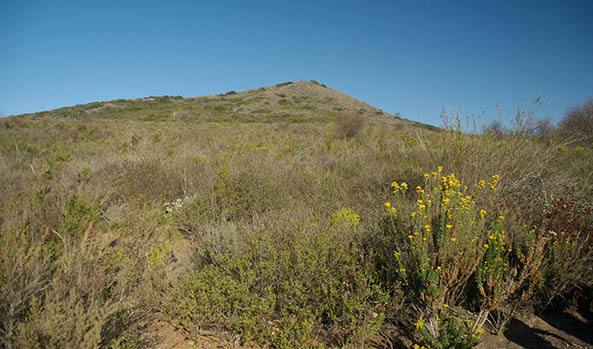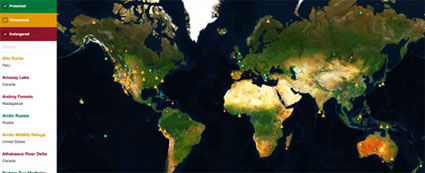
Panhe
| Status | Protected |
| Country | United States |
| Report By | Callie Shanafelt Wong |
| Thanks | Dina Gilio-Whitaker, Colville Confederated Tribe |
| Posted | July 30, 2020 |

For more than 10,000 years, Acjachemen people thrived on the coast of what is now Orange County in southern California. They lived in several villages, but Panhe or “place at the water,” at the mouth of San Mateo Canyon, was the most significant.
Today the Acjachemen consider what is left of Panhe to be their most sacred site. Pre-contact, the village spanned the entire valley now occupied by the Camp Pendleton Marine Base, San Onofre State Beach and much of the town of San Clemente. To this day the tribe conducts ceremony and an Ancestor Walk on a small designated area within San Mateo campground, which is also a burial site. This designated Panhe site is two miles up San Mateo Creek from the world-famous Trestles surf beach, four miles from San Onofre State Beach and five miles from the decommissioned San Onofre Nuclear Power Plant.
The site was almost destroyed a decade ago by a proposed six-lane toll road that would have connected new development to Interstate 5. A coalition of Acjachemen Nation activists, environmentalists and surfers fought the proposal for more than a decade, finally reaching a settlement to protect the site in 2016.
The toll road was essentially blocked in 2008 when the California Coastal Commission denied the project permit. This victory is largely credited to the activism of environmental and surfer organizations. But as Dina Gilio-Whitaker (Colville Confederated Tribes) observes in her master’s thesis, Panhe at the Crossroads: Toward an Indigenized Environmental Justice Theory, the tribe’s claim to the site heavily influenced members of the California Coastal Commission. In a February 4, 2008 letter to commission chairman Patrick Kruer, the Ti‘at Society and Traditional Council of Pimu wrote:
“And…here we are, once again, as native people, in another struggle to protect land that is deemed by us to be sacred. We inherited this obligation from our ancestors. It may be 2008, but those obligations hold a sanctity that we honor. There are numerous communities who are here representing their interest, from surfers protecting their sport, to homeowners fearful of encroaching populations and dwindling real estate prices. Yet, we argue, none of them could possibly understand our dilemma as the original people of this land. Our loss has been significant and yet we continue to fight for the dwindling remnants of land our family has known for countless generations. This is a fact and not a solicitation of sympathy!”
The Land and Its People
The people of the Acjachemen Nation are the original inhabitants of what is now Orange County, and parts of San Diego, Los Angeles and Riverside Counties. For thousands of years, they thrived in oak woodlands, valley meadows and river marshes. As they explain on their website, “The native Acjachemen viewed the land as something sacred that needed to be protected and carefully used to insure the livelihood of their people.”
Two hundred and fifty years ago, Spaniards invaded the area and enslaved the Acjachemen to build many of today’s landmarks, including Mission San Juan Capistrano, which was founded by Junipero Serra in 1776. The Spanish dubbed the people “Juaneño,” as in “of San Juan Capistrano.” Today they are politically organized as the Juaneño Band of Mission Indians/Acjachemen Nation. A tribal council governs the 1,941 blood descendants of the Acjachemen. While they are a state-recognized tribe, they do not have federal recognition and all the rights that would entail.
Current Challenges and Preservation Efforts
In 1981, the U.S. National Park Service determined that Panhe was eligible for the National Register of Historic Places. It was also recorded with the State Historic Preservation Office and included in the San Mateo Archaeological District. After extensive documentation by Acjachemen elders, California’s Native American Heritage Commission added Panhe to its Sacred Lands inventory in 1989. Developers must consult the Sacred Lands inventory as a part of the California Environmental Quality Act (CEQA) environmental review process.
In 2002 local citizens learned of a project proposed by the Foothill/Eastern Transportation Corridor Agency (TCA) to build a six-lane toll road to connect a planned new development with Interstate 5. Two miles of the route would run parallel to San Mateo Creek, a mere 20 feet from the current Panhe site. Environmental groups like the Sierra Club were already concerned about the new toll road being built near environmentally sensitive areas in the San Mateo watershed. But if construction of the toll road destroyed San Mateo Creek, which empties into Trestles surf beach, it could have also disrupted the near perfect wave quality that Trestles is known for. Once surfers understood the threat, “Save Trestles, Stop the Toll Road” bumper stickers, lawn signs and t-shirts sprouted up all over San Clemente. When the surfing community became concerned the issue gained international attention.
In 2006 the California Native American Heritage Commission (CNAHC) brought a lawsuit against the TCA on behalf of the tribe, on the grounds that the destruction of Panhe would seriously infringe Acjachemen religious freedom.
“Construction of the Toll Road as approved by the TCA would cause severe and irreparable damage to a Native American sanctified cemetery, place of worship, religious or ceremonial site, or sacred shrine located on public property.” (Native American Heritage Commission v. Foothill Eastern Transportation Corridor Agency)
In 2007 grassroots Acjachemen activists created the United Coalition to Protect Panhe (UPCC) to assert the importance of the area to the Juaneño Band of Mission Indians/Acjachemen Nation. UPCC became part of a broad coalition of interested parties that aren’t always aligned on issues but succeeded in lobbying the California Coastal Commission to deny the TCA permit in 2008. Many observers may not realize what a role Acjachemen standing had in convincing the commissioners.
In her groundbreaking book, As Long as Grass Grows: The Indigenous Fight for Environmental Justice, from Colonization to Standing Rock, Dina Gilio-Whitaker points out that “what is clear in hindsight is that few people outside the Native community and the Coastal Commission realized the important role Panhe would ultimately play in the fight to stop the toll road.”
Gilio-Whitaker goes on to quote Commissioner Mary Schallenberger, “There is a huge disconnect in understanding between the Native American culture, and the—what would I call it?—the rest of the culture of California…What I learned and came to respect is that for the Native Americans, quite often, their sacred sites are different. They are absolutely tied to, and integral to a specific place on the earth. Churches, synagogues, and, I believe, mosques can be moved. They can be moved, and they can be re-blessed, or whatever that particular religion calls for, and the worship can go on in a different building, in a different place. With the Native Americans, that is often not the case.”
The TCA appealed the Coastal Commission’s decision to the U.S. Commerce Department, but was denied later that year.
Out of fear of further development the coalition formed the Save San Onofre Coalition. In 2016 the coalition reached a settlement with the TCA that if the TCA committed to keeping their route out of the San Mateo Creek watershed the coalition would drop the six lawsuits filed against them.
What You Can Do
If you live in the area, attend the annual Panhe Earth Day event.
Support San Onofre Parks Foundation which serves as a steward of San Onofre State Park and Panhe.
Support Acjachemen sovereignty and the United Coalition to Protect Panhe.
Sources
Gillo-Whitaker, Dina. As Long as the Grass Grows: The Indigenous Fight for Environmental Justice, from Colonization to Standing Rock. Beacon Press, 2019.
Gilio, Dina. “Panhe at the Crossroads: Toward an Indigenized Environmental Justice Theory” (2012).
Juaneño Band of Mission Indians/Acjachemen Nation.
San Onofre Parks Foundation. A Native History.
Moore, Donia. “Who Are The Acjachemen?” San Clemente Journal, August 25, 2016.
Native American Heritage Commission vs. Foothill/Eastern Transportation Corridor Agency, a joint powers authority; the Board of Directors of the Foothill/Eastern Transportation Corridor Agency, and DOES 1-10 (2006) Superior Court of California County of San Diego North County Branch 2006.
State of California. The Resources Agency. California Coastal Commission. Revised Staff Report and Recommendation on Consistency Certification (2008).
Weikel, Dan. “Settlement ends the threat of a toll road through San Onofre State Beach,” Los Angeles Times, November 10, 2016.
Continue Exploring Sacred Sites
 Explore a world of sacred lands and discover more than 100 site reports using our interactive map.
Explore a world of sacred lands and discover more than 100 site reports using our interactive map.